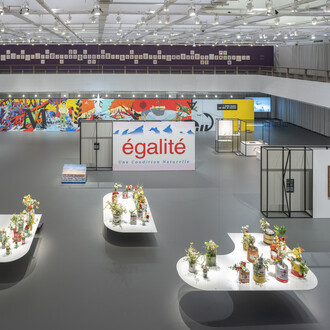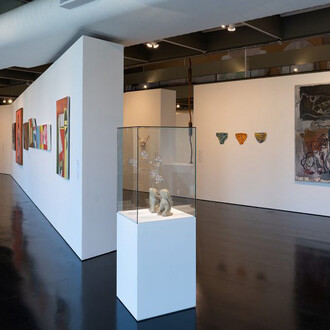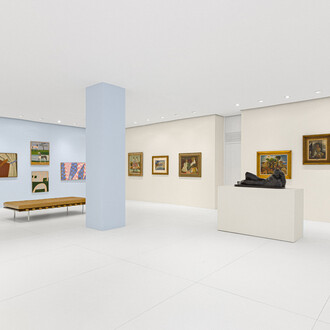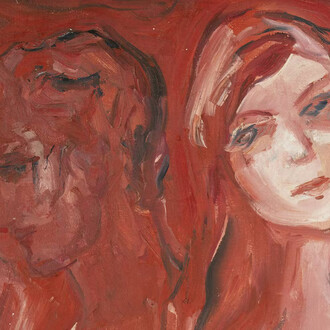A group exhibition is a meeting place even if temporary, and therefore also a place of passage. What is particular to each work is thrown into the multiplicity of the meanings provided by what is rightly part of each work. In the end, given the whole, a confrontation is established not only between works, but also within themselves in a movement that ends up being returned to what is said to be particular in each work. Thus, a collective exhibition always tends to offer a tension between autonomous poetic universes where their relationship are called into question.
Even though the nature of the exhibition is provisional and circumstantial, one is occasionally given the chance to perceive unanticipated affinities and interrelationships that are not intended or foreseen. Perhaps in such occasion lays the power of the device of presentation, which one still refers to as exhibition: the possibility of generating temporary situations that renew our sensibility and broaden our understanding of the experience of the encounter with the practices, strategies and operations of visual artistic production. It is also from this possibility that a place of meeting and passage can become a space of sharing, assembling the idea formulated by Michel de Certeau. In his book "The Invention of the Everyday - Arts of Doing" (Editora Vozes, 1998), there is a chapter entitled, "Accounts of Space", in which the author tries to formulate a distinction between place and space. Place, says Certeau, would be of the order "self", in which the possibility of occupying the same place is excluded (p.202). Space, on the other hand, has nothing to do with the stability of one's positions but rather a crossing of one that transits, animated by all the movements that there unfold (p.202). In short, Certeau says: "space is a place in practice" (p.202).
"O Lugar Como Espaço (The place as space) is a group exhibition that seeks to share a espacial idea as the place of exhibition is practiced. To practice has double meaning: the collaboration between artists and critic - or curator - in the conception of the visuality that one wants to make seen but also the experience of the spectator who enters this field of meanings and completes the course according to its parameters of access and navigation.
If there is a suggested route to be followed, one can start from the room at the entrance of the gallery. There, Túlio Pinto presents three sculptural works that interconnect as they deal with the balances, weights, and the mechanisms of the systems that configures them. Together, "Athar # 5" (2018), "Rectângulo # 3" (2018) and "Cartesianos #01" (2018) establish an installation environment that is not restricted to the materiality of objects, but rather articulate the way they mobilize invisible forces contained in space to remain stable. In a text that accompanies a book about Túlio Pinto still in preparation, I wrote something that seems to me to synthesize the artist's production: "Dealing with tension pushed to the limits, Pinto's sculptural pieces and ensembles create situations that call for us to inhabit them, even if temporarily, making us experience our own bodies as a material presence in the world of things. But they also radiate a seductive appeal to the sight because of the clarity, conciseness and harmony that emanate from the objects, arrangements and constructions. "
From the main room, we arrive at the back of the gallery, where Frantz's works are seen. When approaching painting, whether as practice or as concept, the artist works with his production to create a series of shuffles that focus on the reconfiguration of the sight. Frantz tackles a conceptual approach with which he moves the pictorial to the object, investigating the materiality of painting in the play between true and false, absence and presence, original and appropriation. His objects assembled in the room consist of residues of acrylic paint accumulated in pots and bowls that serve as molds, while his works on the wall are gestures that refer to these same objects as if they were stamps that leave traces and drips of paint on the surface. Leaving the outside area of the gallery, we find the exhibition container, which houses works by 6 other artists. On the ground, in the center, the duo Ío (Laura Cattani and Munir Klamt) presents "Personal Demon IV" (2018), a sculpture endowed with a trap mechanism, before which there is invariable apprehension. Whether through visual seduction or strong tension, there is a dialogue here with the works of Túlio Pinto, particularly by the fact that the trap system is armed with glass borders.
A visual seduction is also rebound in the work of Bruno Borne, with particularities that point to the questioning of the real and the virtual. "Lemniscata # 3" (2018) is an image that relates to the production that the artist performs in video and graphic animation. They are works that converge images of architectures that hybridize to generate new and reinvented architectures, which, in turn, also recreate both the space that originates the work and the one where it is presented.
Another play of appearances, this time between chance and manipulation, appears in the work of Guilherme Dable. In the video "O Domador" (2015), a large sheet of paper keeps fluttering vertically when dealing with lateral forces that act as counterweights and even gravitational support. Here, lightness and softness are close to the work of Bruno Borne, at the same time opposing the physical tension that emanates from the works of Túlio Pinto and the duo Ío.
The use of conceptual strategies approximates the works of two artists. In Lilian Maus's "Memorial de um pé-de-pera” (2017), the artist starts from an intimate experience: her family's ranch in Osório (RS), where one day the tree mentioned in the title was harvested. Surprised by what had happened, the artist sat in front of the scene and there she made a watercolor of the stumps stacked and propped up in the hose. Along with this painting, she presents the first legal document of the land, from 1909, that registered the condition of total devastation of the lands that today are covered by secondary and native forest. The work also includes one of the stumps.
Diego Passos presents "Cachoeira" (2010), whose use of text in the composition next to the photographic image is related to a strand of its production, notably one marked by conceptual strategies from the use of photography as a medium. In this work, the evidence of another operation is present - the performance of the body exploring the status of the self-portrait.
Finally, again painting. Letícia Lopes presents recent works from a series in which she explores the layers of oil paint, using procedures of appropriation, collage and overlap that refer to conceptual strategies performed with ready made images in circulation. But in these works the artist mixes codes between what would result from the hand or what would be the appropriation of the printed media, between practice and concept, in which it establishes a dialogue with the works of Frantz.
In the midst of the different poetics and artistic approaches gathered in this exhibition, one might be tempted to find an immediate correspondence in common - Porto Alegre, the capital of the state of Rio Grande do Sul. In fact, the 8 artists of this exhibition come from the same artistic milieu. However, this little defines the works. It is better to understand them as a coordinate between time and place that informs more about where the encounter and the sharing between their affections occurred, and also from where they begin to cross along their individual trajectories, as is the case of the circumstance offered by this collective.












